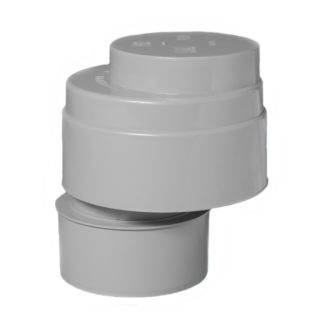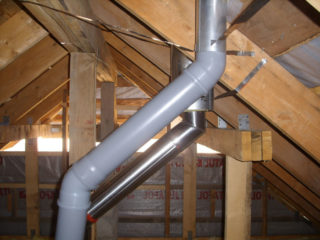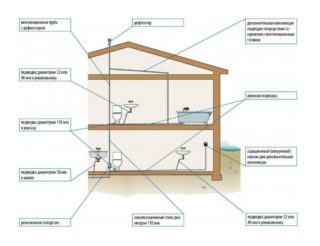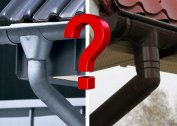The cleanliness of the air in buildings largely depends on the presence of a properly installed sewer system. But the installation of structures for the discharge of dirty drains will not solve the issue of sanitary welfare of the premises completely. Ventilation of a cesspool in a private house, as well as the installation of internal air vents, are necessary to get rid of unpleasant odors.
In what cases do you need ventilation for sewage
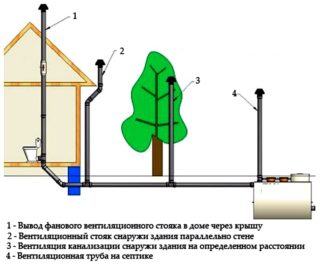 The need for a ventilation device for internal sewage arises in the following cases:
The need for a ventilation device for internal sewage arises in the following cases:
- The house has more than two floors.
- The volume of polluted effluents is quite large.
- The diameter of the central sewer riser is more than 50 mm.
- Plumbing products are installed at various levels of the house.
The device of air ducts from the sewerage is actual for country houses with periodic residence and summer residences. When plumbing fixtures are not used for a long time, water dries in siphons. This makes it possible to receive unpleasant odors from the drainage system into residential premises.
In addition to the air exchange device in the sewer systems inside the house, it is necessary to provide for such an opportunity for the external design. This will prevent gas stagnation in pipes, septic tanks or cesspools.
Types and arrangement of sewer ventilation in a private house
Ventilating the sewer system will solve several major problems at the same time:
- Air passes through the vents, which allows you to adjust the pressure in the entire structure.
- Water locks in siphons of plumbing fixtures remain in good condition. Smells do not enter the premises.
- In closed systems for the diversion of waste products in the process of their processing, methane is gradually released. This threatens poisoning people, or ignition of gases.
The drainage system is usually ventilated with fan pipes or vacuum valves. A good option would be a combination of these details.
Internal ventilation in the house
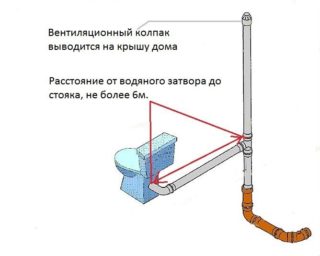 The main way to ventilate the sewer system in the house is to install a fan pipe. It is intended for the removal of gases generated during the discharge in plumbing fixtures.
The main way to ventilate the sewer system in the house is to install a fan pipe. It is intended for the removal of gases generated during the discharge in plumbing fixtures.
A hood inside the house is usually provided at the stage of its design. To do this, equip a separate ventilation shaft. Outwardly, the pipe is discharged through the roof of the building to a height of 3-4 meters above ground level.
Ventilation ducting is also performed in the finished structure. The ventilation scheme of the sewer riser in a private house in this case involves the installation of pipes on the walls of the building.
The option of removing the fan pipe on the fence has its advantages. Aesthetics at home will not be affected, ventilation will be located at a distance from the living area. Among the shortcomings can be noted a greater consumption of materials and the complexity of the work. Most often, the structure is fixed to the guards on brackets or special supports.
External ventilation
 Septic tanks or cesspools are arranged at a distance of at least 5 meters from the building. But all the same, their ventilation is required. In this case, the likelihood of unpleasant odors entering the house is significantly reduced.
Septic tanks or cesspools are arranged at a distance of at least 5 meters from the building. But all the same, their ventilation is required. In this case, the likelihood of unpleasant odors entering the house is significantly reduced.
Most often, a fan riser is mounted on the waste collection tank. Through it, gases are formed resulting from the processing of waste. In addition, with significant volumes of effluent, the ventilation pipe prevents rarefaction of air in the septic tank or pit.
For greater efficiency, air supply pipes are installed near the sewage tank. They come to the surface by 50-100 cm.
Vent valves
Ventilation valves are also installed in the system. They partially solve the problem of adjusting the pressure inside the sewer pipes.
The main disadvantages of using valves:
- When the water dries in the siphon of the plumbing fixture, the valve does not prevent odors.
- Valves are often clogged.
- At low temperatures, the structure freezes and ceases to fulfill its task.
The best option would be to install vacuum valves in addition to fan pipes.
Material selection
The hood in the sewer of a private house is arranged mainly from plastic pipes. They have many advantages in using:
- light weight;
- ease of installation;
- resistance to chemicals and corrosion;
- A wide range of products and fittings.
The size of the parts for the ventilation system depends on the height of the building. A small one-story house is equipped with an air exchanger from pipes with a diameter of 50 mm. For large cottages, it is worth using elements measuring 110 mm.
It is not worth building a drainage system and its ventilation from various materials. In this case, it will be difficult to ensure reliable sealing of the joints of the elements. If the air vent device is produced in old buildings with cast-iron pipes, then the same elements are chosen for ventilation. As an option, dismantle the existing sewer line with the replacement of all parts with plastic ones. In this case, the ventilation pipe is taken from plastic.
Design
To draw up a ventilation scheme for the sewer riser in private homes, the following points should be considered:
- The upper edge of the pipe should be at least 300 cm from the ceiling and 50 cm from the roof material.
- Do not wear a protective cap on top of the vent to avoid condensation and freezing of the structure.
- Do not arrange a ventilation outlet near the edge of the roof.
The sewer air exchanger must not be combined with conventional ventilation or a smoke exhaust system.
Installation Rules
When installing a ventilation structure, the basic rules should be observed:
- The air outlet is carried out through the supporting wall outside the house. A special box is mounted in this place. Pipe bending is performed using bends at 90 degrees. Details are fixed to the wall with brackets or clamps with an attachment step of 200 cm. The structure should be insulated and covered with decorative trim.
- The valves are mounted on a vertical riser and horizontal sections of the drainage design. Most often, they are in addition to the full ventilation of the sewer in a private house. It is recommended to install the valve closer to the vertical riser.
If the ventilation of the sewer riser in a private house is performed correctly, then there should be no extraneous odors in the living quarters. But sometimes their appearance is possible. In this case, it is worth checking a few points:
- Incorrect installation or breakdown of one of the plumbing fixtures, in particular the siphon.
- Violation of the water trap is often associated with the use of small pipes for sewerage. But the reason is the usual clogging.
- Damage to elements in the drainage system - depressurization of joints or cracks in parts.
It is also worth checking the design of the ventilation structure for blockages.
Ventilation of a cesspool in a private house, or a sewer air vent inside the building, is more convenient to perform from plastic parts. This does not require professional skills. Properly assembled design will last a long time and reliably.
